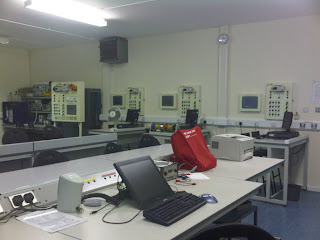I would like to discuss the use of Promethean panels employed in a number of classrooms at my place of work. Many years ago I was the first lecturer to purchase a panel and now due to my efforts these panels are now widespread however a number of fellow educators don't seem to use them why I cannot understand.
 |
| Panel at the front of the classroom |
They work in a similar way to interactive whiteboards but you sit facing your class and as you write it is projected behind you more details can be found on the Promethean website.
What do you think is the likely impact of this technology on the students’ perceptions of the quality of their modules, their approaches to studying and their academic performance?
From my experience of using this tool most students enjoy the enrichment offered, powerpoint presentations come to life a number of whiteboards can be completed and saved for future reference giving a record of the lesson contents. Students still like to make notes of their own but they are more likely to listen if they realise they don't have to make notes. The lessons have a more professional feel to them.
What do you think is the likely impact of this technology on the teachers’ perceptions of their teaching context and their approaches to teaching?
I am more confident facing my audience and watching them rather than facing away from them writing on a board. The fact that lesson contents can be saved enable a truer reflection after the event and a change to go back over past lessons at a later date. It is also possible to prepare whiteboards prior to the lesson helping with those rather difficult derivations or mathematical manipulations that sometimes present a challenge in front of students. So I guess it makes me feel more confident and enables a more structured lesson to be prepared.
Do you think this technology embodies particular assumptions about the nature of teaching and learning in higher education?
Well it assumes a face to face didactic classroom session, but it also offers student interaction most students jump at the opportunity to play with my toys. I wouldn't go so far as to say it offers student centred learning but I have used it for group work activities in a similar way to presenting a group of students with a flipchart to complete.
Are these assumptions likely to promote more positive perceptions, more desirable approaches to studying and better performance on the part of the students?
Yes students like to see lessons that are polished and effective and I believe this tool helps to make this so and printing off copies of the flipcharts instantly is a useful aid to the students, most appreciate any extra help that is available. The lecturer faces the students and is able to quickly pick up on body language and visual signs of confusion. My personal experience has lead me to feel that students are more attentive and tuned into the lesson as a result of this particular tool.

